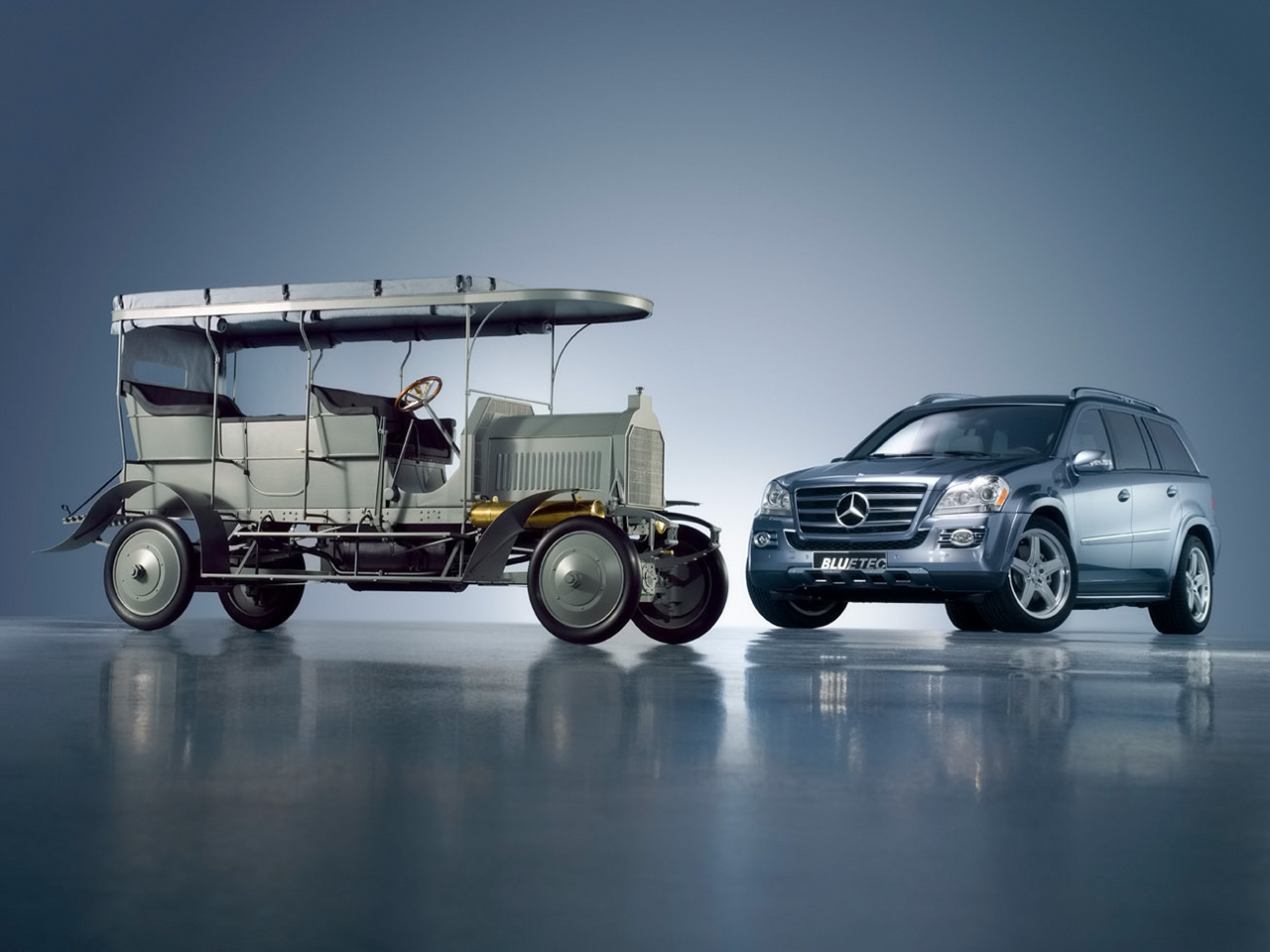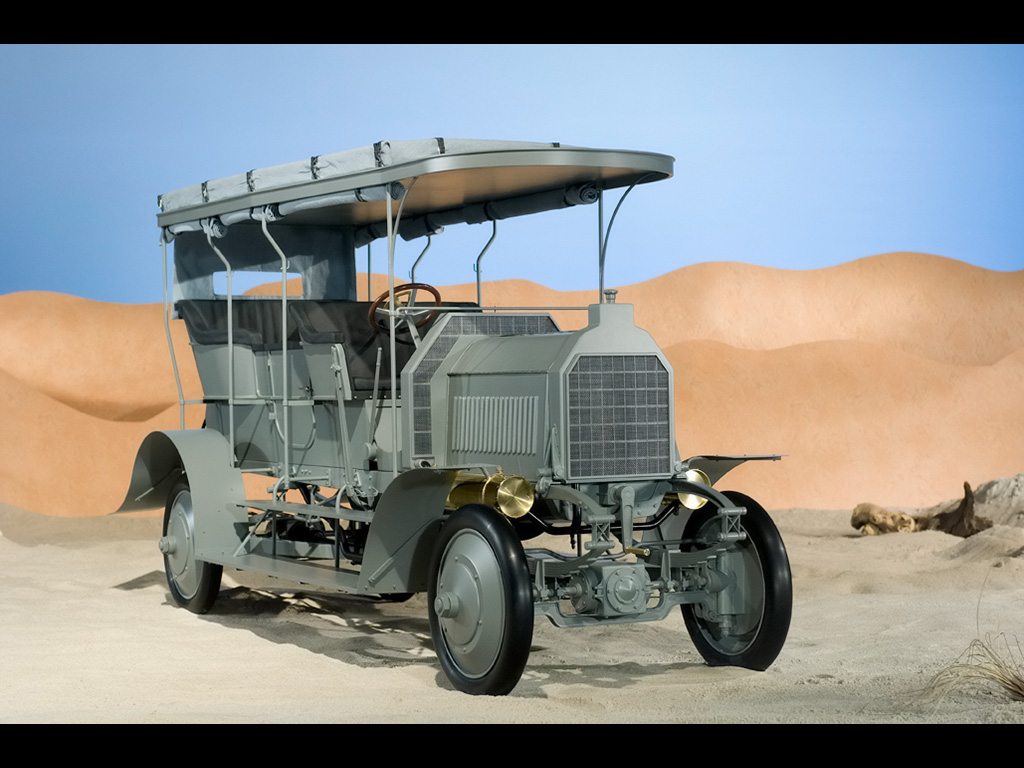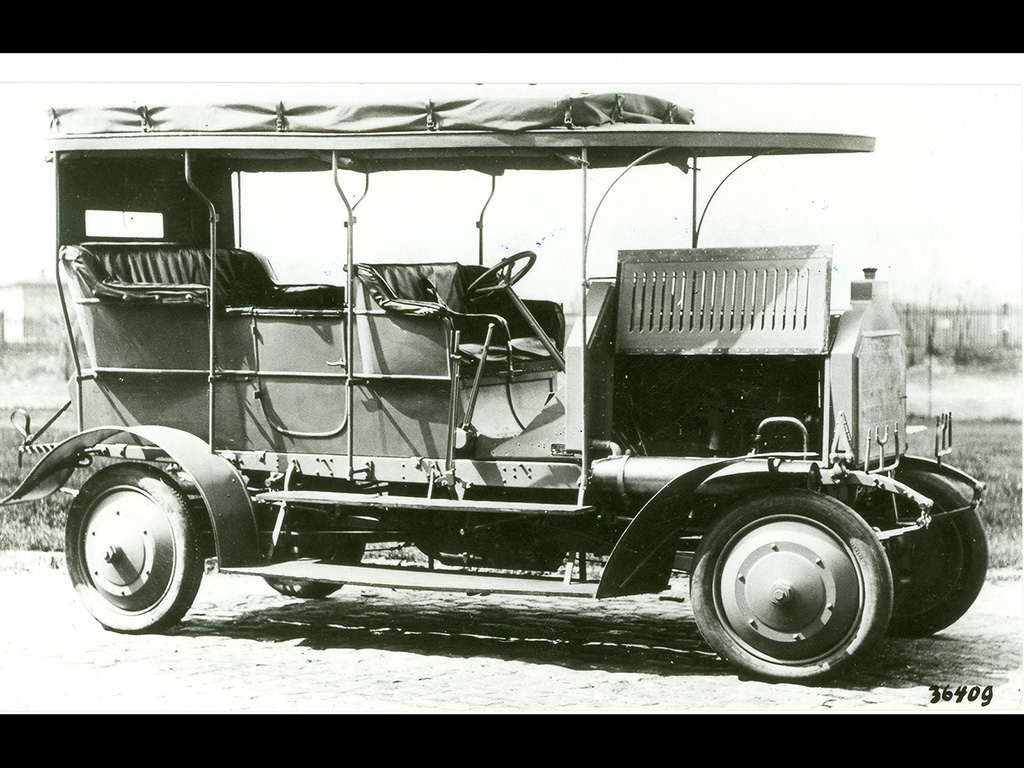1907 Daimler Dernburg Wagen
|
Price |
34,750 Marks |
Production |
-- | ||
|
Engine |
6.8 liter inline-4 |
Weight |
-- | ||
|
Aspiration |
natural |
Torque |
-- | ||
|
HP |
35 hp |
HP/Weight |
-- | ||
|
HP/Liter |
5.1 hp per liter |
1/4 mile |
-- | ||
|
0-62 mph |
-- |
Top Speed |
25 mph |
(from DaimlerChrysler Press Release) The world’s first all-wheel-drive passenger car comes from Daimler-Motoren-Gesellschaft in 1907
* 100 years ago: The “Dernburg-Wagen” features all-wheel-drive and
even all-wheel steering
* Highly sophisticated design by Paul Daimler
* Everyday use in the colony of German South-West Africa, today’s
Namibia
The first all-wheel-drive car for everyday use was built by
Daimler-Motoren-Gesellschaft (DMG) in 1907. The "Dernburg-Wagen", as
it was known, even featured all-wheel steering. It is called after
the then Secretary of State of the Colonial Office Bernhard Dernburg
who drove many a kilometer in it in Africa the following year.
In fact the all-wheel-drive history of the company began slightly
earlier, in 1903, when Paul Daimler laid the foundations for this
technology with a first design draft. The first all-wheel-drive
vehicle appeared in 1904, and was quickly followed by others. Since
then, the watchword has been that all-wheel drive is the best
technology when it comes to better traction and safe, assured
progress. Over the decades it has been successfully used in all
kinds of Mercedes-Benz vehicles, both passenger cars and commercial
vehicles, and from vans to heavy-duty trucks. Some of these models,
for example the G-Class or the Unimog, have gained a legendary
worldwide reputation, and are to be found virtually everywhere on
earth. All-wheel drive also scores heavily in day-to-day driving on
normal roads, however, as the Mercedes-Benz saloons with 4MATIC
demonstrate.
The Dernburg vehicle of 1907
When placing its production order at the beginning of the last
century, the German Colonial Office knew precisely what to expect
from Daimler-Motoren-Gesellschaft (DMG): a reliable vehicle which
would withstand long journeys on unmade roads without complaint,
while offering the flexibility that the motor vehicle had already
amply demonstrated by the beginning of the last century. The
engineer Paul Daimler, son of the company’s founder, was chiefly
responsible for the design of the new vehicle which was finally
built as a one-off at the factory in Berlin-Marienfelde in 1907.
This all-wheel-drive vehicle was based on a DMG commercial vehicle
chassis, and had a wheelbase of four meters with a track width of
1.42 meters. The ground clearance of 32 centimeters was not
unusually large for the time, as almost all vehicles were often used
on heavily rutted unmetalled roads. In 1908 "Allgemeine
Automobil-Zeitung" (AAZ) wrote this about Daimler’s design: "All
higher road obstacles are overcome by the robust front and rear
axles, and the particularly vulnerable lower section of the gearbox
housing is enclosed by a strong steel guard between the pressed
frame cross-members, which is resistant enough to allow the entire
frame to bottom."
The vehicle came on the market for a price of 34,750 Marks. It was
fitted with a touring car body having two seats on the chauffeur’s
bench and four seats in the rear. Only the rear passengers had
doors, and large steps were provided to overcome the entry height of
around one meter. Extending almost to the front end and mounted on
eight poles, a sunshade prevented the driver from being dazzled even
when the sun was low. A luggage rack was mounted on the back for
cases or spare tires, with a further, large luggage rack on the roof
protected by a tarpaulin. Awnings were affixed below the roof on
both sides; these could be lowered to enclose the body and protect
the occupants from wind, weather and sand. "To be sure, this
Mercedes is not noticeable for its light and elegant construction;
it has unmistakable external signs of power and endurance," wrote
AAZ, however: "The overall impression of the vehicle has not
suffered as a result of the special requirements."
Matched to operating conditions with numerous special features
With a length of around 4.90 meters and a height of a good 2.70
meters including the roof structure, the majestic vehicle weighed
around 3.6 tonnes when fully laden with all the special items
specified by the Colonial Office, such as a particularly heavy-duty
clutch and petrol and coolant reserves for tropical conditions,
replacement parts and tools.
Despite this the four-cylinder engine performed manfully, delivering
a very respectable output of 35 hp (26 kW) from a displacement of
about 6.8 litres at 800 rpm – allowing a maximum speed of around 40
km/h on level tarmac. In view of the intended operating conditions,
the climbing ability made possible by the all-wheel drive was
however more important: it was an outstanding 25 percent. The
vehicle featured permanent all-wheel drive, the engine delivering
its power to the four wheels via a sophisticated mechanical system.
A shaft connected it to the centrally installed gearbox, which had
four forward gears and one reverse gear. From there prop shafts
transferred the torque to the front and rear axle differentials,
which in turn used bevel gears to split and transfer it to the
wheels.
Mechanical components protected against airborne sand
The designer Paul Daimler took special precautions to keep airborne
sand out of the drive components. Many of the joints were packed
with lubricating grease to keep sand at bay and prevent rapid wear,
but the front axle proved to be a real challenge at first: owing to
the expected heavy impacts and fine airborne sand, it was not
possible to use the usual protection for the bevel gears on the
wheels, a telescopic system which followed the steering movements.
Daimler shrouded the vulnerable components with a robust,
cylindrical sleeve, but because this solution limited the maximum
steering angle to just 23 degrees, the vehicle was also equipped
with steered wheels at the rear to achieve a reasonable turning
circle. The rear wheels were also encapsulated as a protection
against airborne sand. One positive side-effect was that the front
and rear axle components, including the differentials, wheels and
brakes, were of identical construction, which considerably
simplified the provision of replacement parts.
The solid steel wheels also served to protect the mechanical
components and drum brakes against soiling; wheels with wooden (and
more rarely steel) spokes were usual at the time, however these
would have let sand into the drive components. Moreover, spoked
wheels would have made it practically impossible for the vehicle to
free itself after sinking into the sand. The steel wheels were shod
with size 930 x 125 pneumatic tires, another unusual feature as
solid rubber tires were still in widespread use at that time.
Presumably Paul Daimler made this choice to assist the robust leaf
springs in their work in view of the vehicle’s high weight. Not
unusually for the time, only the rear tires carried a tread while
the front tires had a smooth surface. The tire valve was located on
the inside of the wheel so that it was not so exposed to damage.
The cooling system was specifically configured for the tropical
climate, with a larger cooling surface, a larger cooling mantle
around the cylinders and more coolant – the circuit contained 140
litres in total. In addition to the radiator at the front end, a
second radiator was mounted on the front bulkhead, enclosing it in
horseshoe fashion and extending its honeycomb structure into the
slipstream. Both radiators were connected via two side-mounted water
reservoirs, and the heated water had to pass through all the lines
and tanks before flowing around the cylinders again. "Even in deep
sand at only 8 km/h, the cooling system performed admirably during a
one-hour endurance test," AAZ reported.
Extensive testing under realistic conditions
At the end of March/beginning of April 1908, the colonial vehicle
was subjected to a thorough, 1677-kilometer trial in Germany. The
route ran from Berlin-Marienfelde to Stuttgart-Untertürkheim and
back. Untertürkheim was reached during the morning of the fourth
day, and four days later, the car was back in Marienfelde. The route
included off-road sections, too, so as to test the all-wheel drive.
“A turn in a deeply ploughed field with a gradient of five to ten
percent was negotiated impeccably,” a Colonial Office report stated.
“Near Wittenberg the vehicles was driven into a sandpit, in which it
sank well up to its axles in the sand, but from which it managed to
free itself with ease despite gradients of 20 and 21 percent.” In
the Thuringian Forest, “a hill approximately 150 meters high was
climbed on stony, twisting, narrow roads with gradients of up to 20
percent without difficulty. Even the steering, which was inherently
cumbersome as a result of the four-wheel drive, proved itself.” The
Colonial Office’s test report was positive.
In May 1908 the vehicle was shipped to Swakopmund in Africa on board
the “Kedive”. The Secretary of State at the German Colonial Office,
Bernhard Dernburg (1865 -1937) received it for his personal disposal
in German South-West Africa one month later. His task was to
coordinate and improve relations between the colonies and the
motherland. As a result of his travels the all-wheel-drive vehicle
was nick-named the "Dernburg-Wagen" many years later. At the same
time, these trips served as a general test of the motor vehicle as a
means of transport in the colony, and to this purpose the
all-wheel-drive “Dernburg” was accompanied at least some of the time
by other, rear-wheel-drive, vehicles from Benz and Daimler, namely a
seven-seater, extensively armoured car from Benz and three trucks
from Daimler.
The author of a travel report from that time described a journey
with the Dernburg as follows: “The 600-kilometer trip from
Keetmanshoop via Berseba to Gibeon and then from Maltahöhe, Rehoboth
to Windhoek was made in a journey time of four days without
accident. That is an enormous time-saving, since for the same
journey an accomplished rider takes twelve days on horseback […].”
And the official was even able to use a mobile communication aid,
too: “When [the vehicle] was carrying Secretary of State Dernburg,
it also took a field telephone which was able to be tapped into the
telegraph wires anywhere along the way.”
In permanent service by the police
Following this trip, the car was made available to the police in
German South-West Africa as a means of transport on a permanent
basis. A precise log was also kept, showing for instance that the
vehicle had covered around 10,000 kilometers by the beginning of
1910.
The car’s driver, who also doubled as its mechanic, was sent by
Daimler-Motoren-Gesellschaft along with the vehicle – common
practice at the time. And since it belonged to the police, without
further ado driver Paul Ritter was made a policeman. Following
Dernburg's departure, Ritter remained in the country to look after
the car, repeatedly returning to Marienfelde so as to acquire the
required spare parts, as well as the repair and maintenance skills
to go with them.
The details known about the “Dernburg” all point to the engineering
ability of Paul Daimler, who tailored the car’s design precisely to
its intended application. Every single feature was thought through
so that the vehicle made no compromises with regard to its chief
purpose – driving in trackless terrain.
Despite this, the journeys undertaken with the car did not go as
smoothly as those involved would have liked. This was because its
high weight, due in large measure to the Colonial Office’s special
requirements, meant that the pneumatic tires were subjected to a lot
of punishment. This meant that, particularly with the amount of
off-road driving that had to be done, they only lasted a
comparatively short time – 36 tires and 27 inner tubes were used up
in the above-mentioned 10,000 kilometers covered by early 1910.
Experiments with solid rubber tires proved unsuccessful, since the
forces acting on the wheels were then too much, and destroyed them.
The all-wheel drive, by contrast, proved its worth particularly on
sandy surfaces, on which the car made better progress than the
accompanying rear-wheel-drive trucks. Despite this, after a detailed
inspection a police colonel submitted a recommendation to convert
the car to pure rear-wheel drive: the numerous components of the
all-wheel-drive system made it complicated and time-consuming to
maintain and repair. This conversion then apparently did actually
take place, but the precise details have not been handed down. There
are no records on how the car was used during the First World War.
After it, and after the end of German colonialism, all trace of the
“Dernburg” was lost – its fate is unknown. Paul Ritter, its driver
and mechanic, returned to Marienfelde in 1919 where he once more
found employment with Daimler-Motoren-Gesellschaft.



